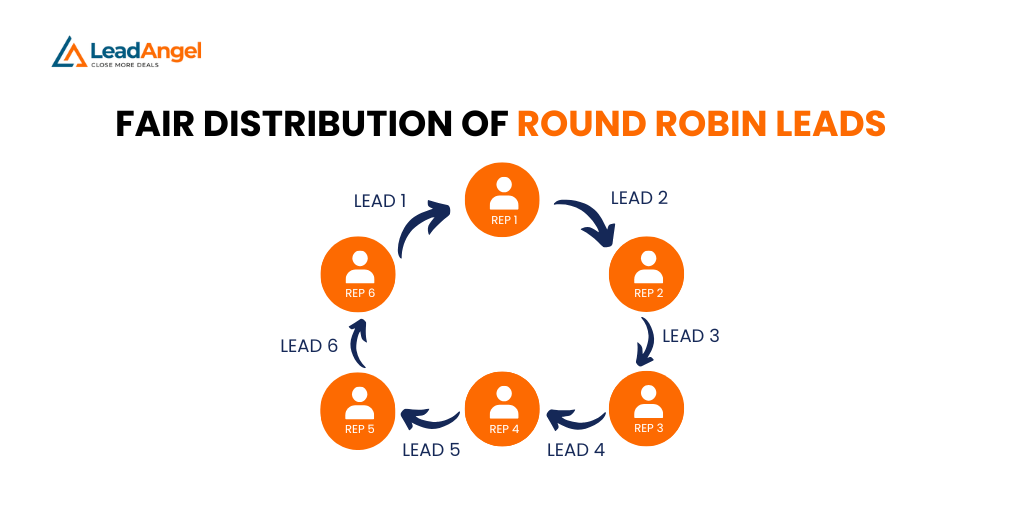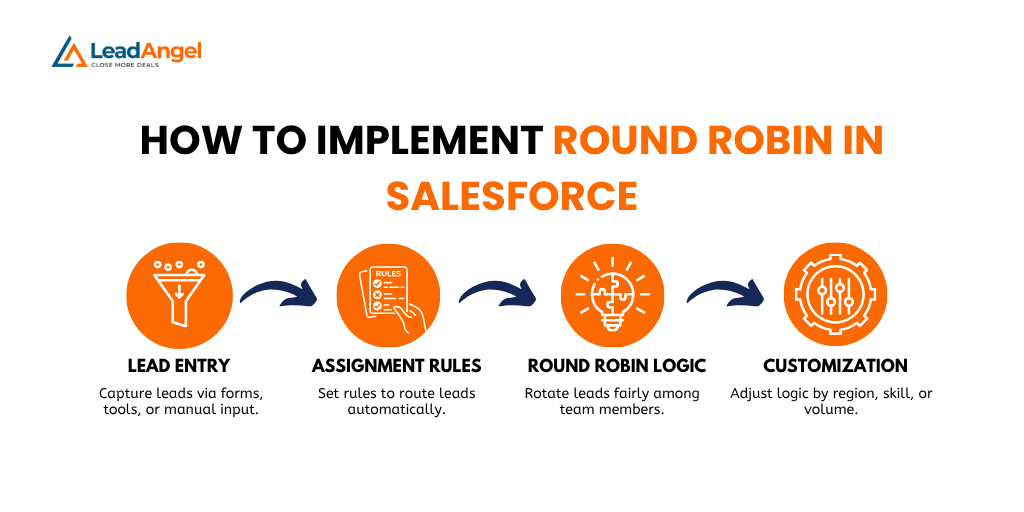Managing lead distribution manually frequently results in delays, inconsistencies, and uneven workloads throughout sales teams. That’s where the Round Robin leads project gives a scalable, systematic result. Round Robin eliminates bias and speeds up response times by rotating through a predetermined list of sales representatives to ensure that each incoming lead is assigned in a fair and sequential manner and balancing team capacity.
This approach is especially powerful in high-quantity environments where speed and integrity are critical. Integrated within CRM platforms like Salesforce or HubSpot, it could be fully computerized using workflows, regulations, or custom logic, ensuring seamless operation without guide intervention.

This article explores the concept of round robin lead assignment, a systematic approach to distributing leads uniformly among sales reps. We’ll cover its key benefits, which include advanced response time, balanced workloads, and better sales team performance. Additionally, you will learn how to expedite your lead management process by integrating automated tools and nice practices into your CRM.
What is round robin lead distribution?
One technique for allocating leads to sales representatives in a cyclical and rotating manner is called “round robin lead distribution.” When a new lead enters the arrangement, it’s miles assigned to the next available rep within the queue, making sure each rep receives the same number of leads over time.
Unlike manual assignment or rule-based systems that may favor particular reps, Round Robin confirms fairness and transparency in the distribution process. This balanced technique supports and maintains productivity across the team, especially in high-volume sales environments.
Round Robin can be implemented using lead assignment rules in Salesforce, custom logic through Flows, or additional tools. Compared to traditional assignment methods, this model reduces administrative overhead and makes sure no lead falls through the cracks due to uneven distribution.
Benefits of Round Robin Lead Assignment
Round Robin isn’t just about fairness—it’s a strategic approach to lead distribution that boosts efficiency, improves team dynamics, and supports scalable growth. Here’s how it adds value to your sales process.
a) Fair Distribution of Round Robin Leads
Round Robin ensures that no single sales rep is overpowered with too many leads while others have little to work on. This balance promotes a constant workload and maximizes overall team output. Let’s say you have four reps: A, B, C, and D. The lead flow would look like this:
Lead 1 → Rep A
Lead 2 → Rep B
Lead 3 → Rep C
Lead 4 → Rep D
Lead 5 → Rep A (and the cycle repeats)
This ensures leads are assigned fairly, minimizing the risk of overloading one rep while others wait.

b) Improved Sales Team Morale
By getting rid of favoritism from the lead assignment procedure, every team member is given an equal shot at success. This fairness nurtures belief and encourages healthful inner competition.
c) Faster Response Times
With automation in place via lead assignment rules Salesforce, leads are immediately routed to the next rep without delays. This brief response capability may be the difference between prevailing and losing a deal.
d) Scalability for Growing Teams
As your sales team expands, Round Robin easily scales. You can add new reps to the rotation seamlessly, and Salesforce rules can be adapted to accommodate changing team structures or sales territories.
How To Implement Round Robin in Salesforce
Getting leads to the right sales reps fast—and fairly—is crucial for keeping your sales procedure clean. One way to do this in Salesforce is by way of using the Round Robin task, which allows sharing leads frivolously among team participants. It cuts down on manual work, avoids overload on any one rep and continues to follow up on instances steadily. Here’s how you can install this kind of lead distribution for your Salesforce surroundings.
Step 1: Lead Entry into Salesforce
Everything starts when a new lead enters your CRM. This can happen through:
- Web forms on your site,
- Third-party integrations like marketing automation tools,
- Manual entry by a team member.
When a lead enters the framework, Salesforce uses assignment rules to determine who must handle it and how it should be routed.
Step 2: Activate Lead Assignment Rules Salesforce
Salesforce Lead assignment rules are a built-in feature that automatically routes leads based on standards that include geography, industry, product interest, or any custom field. These rules serve as the foundation for initiating Round Robin Salesforce logic.
You’ll first need to create or edit a lead assignment rule:
- Go to Setup > Lead Assignment Rules.
- Define conditions based on your routing strategy.
- Assign leads using a custom logic or via Apex triggers and flows that incorporate the round robin method.
Step 3: Implement Round Robin Logic
With your assignment rules in place, you now set up the round robin logic. Here’s the way it works:
Automated Rotation: When a lead is captured, it is mechanically assigned to the following sales rep within the queue.
Skip Unavailable Reps: If a rep is unavailable (e.g., on leave), the system can pass them and assign the result to the subsequent individual.
Looping Assignment: After the remaining rep receives a lead, the cycle starts again from the first, making sure of fair and continuous distribution.
You can put this into effect using Salesforce Flows, Apex code, or outside gear that integrates with your CRM. Admins regularly use a custom item or counter to tune the final rep assigned and update it with each new lead.
Step 4: Customize Your Round Robin Salesforce Setup
Salesforce is highly customizable, allowing you to adapt the Round Robin assignment Salesforce logic to suit your team’s needs:
- Weighted Round Robin: Reps can be assigned leads based on experience or performance. For example, top performers may also acquire a higher volume of leads.
- Criteria-Based Routing: Combine Round Robin with conditional rules. For example, assign EMEA results in one institution, while North American leads rotate through another.
By combining Salesforce lead challenge policies with customized common sense, you create a sturdy, automated distribution arrangement tailored to your commercial enterprise goals.

Best Practices for Round Robin Lead Management
To maximize the effectiveness of the round robin lead venture, pass the basic setup and adopt strategic practices tailored to your sales targets.
- Set Specific Criteria: Guide leads more effectively by the use of elements like vicinity, product interest, or level within the sales cycle to ensure the proper reps get the proper opportunities.
- Track and Optimize: Regularly verify project styles to keep balance, particularly as your team expands or roles evolve.
- Integrate Lead Scoring: Focus on high-capability leads with the aid of pairing Round Robin with a scoring device, making sure top potentialities receive instantaneous interest.
- Analyze Performance: Use Salesforce dashboards to reveal lead distribution, reaction times, and rep productivity, making data-driven changes as desired.
These practices help you go beyond primary automation and flip Round Robin into a strategic benefit.
Round Robin lead distribution is more than only an honest way to assign leads—it’s a device that drives speed, transparency, and team morale. When integrated with Salesforce lead assignment rules, it will become a scalable, computerized workflow that eliminates inefficiencies and boosts conversion rates.
If your sales group struggles with uneven workloads or delayed follow-ups, Round Robin is probably the missing piece.
Need help setting up Round Robin in Salesforce? Contact us today and streamline your lead management for good.
See How LeadAngel Can Transform Your Lead Management
Curious to experience the power of LeadAngel firsthand? We understand!
We're offering a complimentary trial so you can explore LeadAngel's features at your own pace. Once you request a free trial, we'll schedule a personalized onboarding session to ensure you maximize the value of LeadAngel.
Ready to take your lead management strategy to the next level? Request your LeadAngel trial today!
In addition to exploring the platform, we recommend visiting our LeadAngel Help Center for in-depth guidance. Our dedicated customer support team is also available to answer any questions you may have at sales@leadangel.com.
FAQs
Picture this: You and your buddies are sharing a jar of sweets. Instead of letting one person hog all the exceptional pieces, you are taking turns picking—first your flip, then your friend's, and so on down the line. Round Robin lead distribution works the same way for sales teams. When new leads (potential customers) come in, the system gives the first lead to Rep #1, the next to Rep #2, and so on. Once everyone gets one, it starts over.
To enforce round robin lead tasks, you may use CRM tools like Salesforce Flows, HubSpot Workflows, or third-party routing apps. The process involves putting in a rotation of good judgment that tracks the remaining assigned rep and assigns the following result to the rep within the series, making sure balanced lead distribution is automatically maintained.
Round Robin lead routing guarantees leads are allotted lightly across your sales team, stopping overload on man or woman reps and lowering response times. By keeping a balanced workflow, it facilitates boosting productivity, improves lead follow-up consistency, and creates a fairer arrangement that motivates your crew to carry out to their satisfaction.
You can configure round robin assignment in Salesforce using tools like Flows, Apex triggers, or third-party lead routing apps. Salesforce Flow allows you to create custom good judgment that cycles through consumer queues, even as Apex can provide more advanced manipulation. For a no-code option, consider apps from AppExchange that offer prebuilt round robin functionality.
Lead assignment rules in Salesforce allow you to define conditions that trigger how leads are routed. While standard rules assign based on criteria, combining them with round robin logic—via user queues or automation—ensures that leads meeting specific conditions are distributed evenly among qualified reps. This hybrid approach enhances both precision and fairness in lead management.
